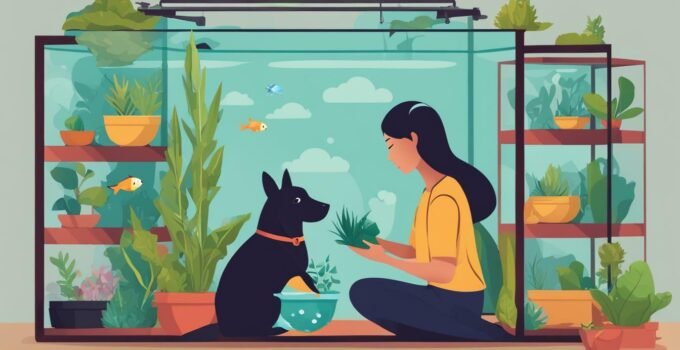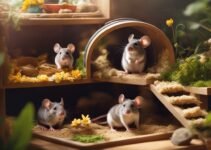Are you searching for a low-maintenance pet that requires minimal care and effort? Look no further! We have compiled a comprehensive guide to help you discover the ideal companion that suits your needs and provides a stress-free experience.
Key Takeaways:
- Choosing a low-maintenance pet requires considering your own lifestyle and preferences.
- Some low-maintenance pets include hamsters, guinea pigs, betta fish, turtles, snakes, and birds.
- These pets have varying needs in terms of food, water, habitat, and social interaction.
- While some pets are independent and require less interaction, others may crave socialization and stimulation.
- The best low-maintenance pet is one that aligns with your lifestyle and provides the companionship you desire.
When it comes to choosing a low-maintenance pet, it’s important to find one that aligns with your lifestyle and preferences. Some options you may consider are hamsters, guinea pigs, betta fish, turtles, snakes, leopard geckos, birds, hermit crabs, sea monkeys, snails, dwarf frogs, ants, and rabbits. These pets have varying needs when it comes to their diet, water requirements, habitat setup, and level of social interaction. While some pets are more independent and require less effort, others may need more attention and stimulation. It’s crucial to choose a low-maintenance pet that suits your lifestyle and provides the companionship you desire.
Types of Low Maintenance Pets
In this section, we will explore a variety of low maintenance pets that you can consider. From small mammals like hamsters and guinea pigs to aquatic creatures like betta fish and turtles, there are plenty of options to choose from. These pets have differing needs when it comes to food, water, habitat, and social interaction, so it’s important to consider your own lifestyle and preferences when making a decision.
If you’re looking for a small cuddly companion, hamsters and guinea pigs are great choices. They require minimal space and can be easily housed in a small cage or enclosure. With their friendly and docile nature, they make great pets for both individuals and families.
If you prefer an underwater friend, betta fish and turtles are low maintenance options. Betta fish are beautiful and require a small tank with clean water. Turtles, on the other hand, need a larger tank with a basking area and UVB lighting. Both pets require regular feeding and monitoring of their habitat, but their overall care needs are relatively simple.
For those interested in reptiles, snakes, leopard geckos, and dwarf frogs are low maintenance choices. Snakes are easy to care for, requiring minimal interaction and feeding. Leopard geckos are low maintenance reptiles that are docile and easy to handle. Dwarf frogs are small aquatic frogs that thrive in small enclosures with clean water.
| Type of Pet | Considerations |
|---|---|
| Hamsters | Small cage, bedding, exercise wheel, fresh food, and water |
| Betta Fish | Small tank, clean water, proper filtration, and regular feeding |
| Turtles | Aquatic tank, basking area, UVB lighting, proper filtration, and regular feeding |
| Snakes | Proper temperature and humidity, enclosure, regular feeding |
| Leopard Geckos | Enclosure with appropriate temperature and humidity, hiding spots, regular feeding |
| Dwarf Frogs | Small aquatic tank, clean water, proper filtration, and regular feeding |
When it comes to birds, there are many low maintenance options such as birds. They require a cage with enough space to move around, fresh food, water, and regular cleaning of their living space. Birds can be entertaining companions, as they are known for their chirping and singing.
If you prefer something outside the traditional pet realm, hermit crabs, sea monkeys, snails, and ants can be intriguing choices. Hermit crabs require a terrarium with sand, water, and shells for them to change into. Sea monkeys are easy to care for and only need regular feeding. Snails are low maintenance pets that require a small terrarium with moisture and food. Ants are fascinating creatures that can be housed in an ant farm and require a regular supply of food and water.
Ultimately, the best low maintenance pet is one that aligns with your lifestyle and provides the companionship you desire. Consider your own needs, space limitations, and available time for care when selecting a low maintenance pet. With the right choice, you can enjoy the benefits of pet ownership without overwhelming yourself with a high level of care and responsibility.
Small Mammals
If you prefer furry companions, small mammals like hamsters, guinea pigs, and rabbits make excellent low maintenance pets. These adorable creatures are known for their compact size and minimal care requirements. Hamsters are popular for their small size, low cost, and ability to adapt to various living conditions. They only require a small cage, a wheel for exercise, and a regular supply of food and water.
Guinea pigs, on the other hand, are friendly and sociable animals that thrive on companionship. They require a slightly larger cage with plenty of space to roam, as well as a balanced diet that includes fresh fruits and vegetables. Guinea pigs also enjoy interactive toys and regular handling to keep them happy and mentally stimulated.
Rabbits, with their long ears and adorable hopping behavior, can bring joy to any household. They are low maintenance pets that require a spacious enclosure, regular grooming, and a diet rich in hay, vegetables, and pellets. Rabbits also benefit from social interaction and playtime, so make sure to spend quality time with your furry friend.
| Pet | Cage Size | Diet | Interaction |
|---|---|---|---|
| Hamsters | Minimum 12×18 inches | Hamster pellets, fresh fruits, and vegetables | Regular handling, minimal socialization |
| Guinea Pigs | Minimum 7.5 sq ft for one, more for pairs/groups | Hay, pellets, fresh fruits, and vegetables | Regular handling, socialization with other guinea pigs |
| Rabbits | Minimum 12 sq ft for small breeds, more for larger breeds | Hay, fresh vegetables, and limited pelleted food | Regular handling, socialization, playtime |
When it comes to small mammals, it’s important to provide them with a suitable environment that meets their specific needs. This includes a comfortable and secure cage, access to fresh water and a balanced diet, regular veterinary care, and opportunities for mental and physical stimulation.
Remember, while small mammals may require less care compared to some other pets, they still need love, attention, and a safe and enriching environment to thrive. By choosing a small mammal as your low maintenance pet, you can enjoy the benefits of having a furry friend without the high demands of some larger animals.
Aquatic Pets
Aquatic pets, such as betta fish and turtles, are an excellent choice for those seeking low maintenance companions. Their unique characteristics and straightforward care requirements make them ideal for individuals with busy lifestyles or limited experience in pet ownership.
When it comes to betta fish, also known as Siamese fighting fish, their vibrant colors and graceful movement make them a captivating addition to any home. These small, freshwater fish require minimal space and can thrive in small tanks or bowls. Their diet consists mainly of high-quality betta pellets or flakes, and regular water changes are essential to maintain a clean and healthy environment. Betta fish are relatively independent and do not require much social interaction, making them perfect for busy individuals.
Turtles are another popular choice for aquatic pets due to their longevity and low care needs. They can be kept in tanks or outdoor ponds, depending on the species and climate. Turtles primarily feed on a combination of commercial turtle pellets, fresh vegetables, and occasional live or frozen prey. Regular tank maintenance, including water filtration and temperature control, is crucial for their well-being. While some turtles enjoy human interaction, they can also be content spending time alone. Overall, turtles offer a unique and low maintenance pet experience.
Table: Aquatic Pets Comparison
| Aquatic Pet | Space Requirements | Diet | Social Interaction |
|---|---|---|---|
| Betta Fish | Small tank or bowl | Betta pellets or flakes | Minimal |
| Turtles | Tank or outdoor pond | Turtle pellets, vegetables, occasional prey | Varies by species |
Reptiles and Amphibians
If you’re looking for a unique and low-maintenance pet, reptiles and amphibians can be a fascinating choice. Snakes, leopard geckos, and dwarf frogs are just a few examples of these captivating creatures that require minimal care. Let’s explore each of them in more detail:
Snakes
Snakes are known for their distinctive appearance and intriguing behavior. They are relatively low maintenance pets, requiring minimal social interaction and feeding. Snakes are carnivorous animals, and their diet typically consists of frozen rodents that can be easily obtained from pet stores. They also need a well-maintained habitat with appropriate heating and lighting to ensure their comfort.
Leopard Geckos
Leopard geckos are small reptiles that make excellent pets for beginners. They have a docile nature and are relatively easy to handle. Leopard geckos are insectivores and feed on a diet of crickets and mealworms. They require a well-furnished enclosure with a heat source, hiding spots, and a shallow water dish for drinking and bathing.
Dwarf Frogs
Dwarf frogs are aquatic creatures that are ideal for those interested in maintaining an aquatic environment. These tiny frogs have unique behaviors and are relatively low maintenance. Dwarf frogs mainly feed on small invertebrates, such as bloodworms and brine shrimp, and their habitat requires a well-maintained aquarium with clean water and appropriate temperature conditions.
Reptiles and amphibians can be intriguing pets that offer a unique and educational experience. However, it’s important to research and understand the specific needs and requirements of each species before deciding to bring them into your home. With proper care and attention, snakes, leopard geckos, and dwarf frogs can provide years of enjoyment as low maintenance companions.
| Species | Main Diet | Habitat Requirements |
|---|---|---|
| Snakes | Frozen rodents | Well-maintained habitat with appropriate heating and lighting |
| Leopard Geckos | Crickets and mealworms | Well-furnished enclosure with heat source, hiding spots, and shallow water dish |
| Dwarf Frogs | Small invertebrates like bloodworms and brine shrimp | Aquarium with clean water and appropriate temperature conditions |
Birds as Low Maintenance Pets
If you’re looking for a low maintenance pet that brings joy and companionship to your life, consider birds. Birds can be a wonderful addition to your home, providing entertainment with their cheerful chirping and vibrant feathers. They require relatively minimal care compared to other pets, making them an ideal choice for busy individuals or those seeking a low effort pet.
Dietary Needs and Feeding
When it comes to feeding your bird, a balanced diet is essential for their health and wellbeing. Most birds thrive on a diet consisting of high-quality pellets or seeds, supplemented with fresh fruits, vegetables, and occasional treats. It’s important to research the specific dietary requirements of the bird species you choose to ensure they receive the necessary nutrients.
| Bird Species | Main Diet | Additional Foods |
|---|---|---|
| Parakeets | Pellets or seeds | Fresh fruits and vegetables |
| Cockatiels | Pellets or seeds | Fresh fruits and vegetables, occasional millet spray |
| Canaries | High-quality seeds | Dark leafy greens, grated carrots |
Habitat Requirements
Providing a suitable habitat for your bird is crucial for their comfort and overall wellbeing. Depending on the species, birds may require an adequately sized cage with perches, toys, and opportunities for exercise. It’s important to ensure the cage is kept clean and free from any potential hazards such as toxic materials or small openings that they could get stuck in.
Social Interaction
Birds are highly social creatures and enjoy spending time with their human companions. While some species may require more social interaction than others, it’s important to dedicate time daily to bond with your feathered friend. This can include talking to them, offering them toys or puzzles for mental stimulation, or even simply being in the same room as them.
Overall, birds make for enjoyable and low maintenance pets, bringing beauty and charm to your home. With proper care, attention, and a comfortable habitat, birds can live long and happy lives while providing you with endless entertainment and companionship.
Invertebrates
Invertebrates offer an intriguing world of low maintenance pets, from the captivating nature of hermit crabs to the fascinating colonies of ants. These unique creatures can be a great choice for those seeking a pet that requires minimal care and provides a different kind of companionship. Let’s explore some popular invertebrate pets and their specific needs.
Hermit Crabs
Hermit crabs are captivating creatures known for their interesting shell-swapping behavior. They require a suitable habitat with a mix of sand and moist substrate, as well as a shallow dish of freshwater. These low maintenance pets feed on a varied diet, including commercial hermit crab food, fresh fruits and vegetables, and calcium-rich supplements. Providing an extra shell for them to change into is essential for their well-being.
Ants
Ant colonies can be a mesmerizing addition to your home, offering a glimpse into the organized and industrious lives of these social insects. Maintaining an ant farm requires minimal effort, with specialized kits available that provide everything the colony needs. These low maintenance pets primarily feed on sugar-based solutions or specially formulated ant food, while the queen lays eggs and the workers create intricate tunnels and chambers.
Snails
Snails are fascinating creatures that can thrive in a low maintenance environment. They require a simple setup with a substrate and a shallow dish of water for hydration. Snails feed on a variety of plant matter, and it’s important to provide a balanced diet that includes calcium-rich foods and occasional supplements. These low effort pets not only add visual interest to your space but also help to naturally control algae growth in aquariums.
As you consider invertebrates as low maintenance pets, it’s important to research and understand the specific needs of each species. Pay attention to their dietary requirements, habitat setup, and level of interaction they need. By choosing a low maintenance pet that aligns with your lifestyle, you can enjoy the unique charm and companionship these fascinating creatures bring to your home.
| Invertebrate Pets | Examples |
|---|---|
| Hermit Crabs | Coenobita spp. |
| Ants | Various species |
| Snails | Various species |
Considerations for Choosing a Low Maintenance Pet
When choosing a low maintenance pet, there are several important considerations to keep in mind to ensure their well-being and your own satisfaction. These considerations include their dietary needs, water requirements, habitat setup, and the level of social interaction they need.
First and foremost, understanding the specific dietary needs of your low maintenance pet is crucial. Different animals have different nutritional requirements, so it’s essential to provide them with the appropriate food. Whether it’s pellets, fresh fruits and vegetables, or a specific diet, make sure you have a good understanding of their dietary needs and are prepared to provide the necessary nutrition.
Along with food, water is a basic requirement for any pet. Considering the water requirements of your low maintenance pet is essential to their overall health. Some animals, like betta fish, have specific water temperature and filtration needs. Others, like turtles, require a water source that is large enough for them to swim and exercise. Ensuring that you can meet their water requirements is essential for their well-being.
The habitat setup for your low maintenance pet is another crucial consideration. Depending on the type of pet, you may need to provide them with a suitable enclosure or tank that meets their specific needs. This includes factors such as temperature, lighting, substrate, and hiding spots. Creating an environment that mimics their natural habitat will contribute to their comfort and overall happiness.
Last but not least, considering the level of social interaction your low maintenance pet requires is important. While low maintenance pets typically don’t require the same level of interaction as more high-maintenance pets, they still have social needs. Some pets may enjoy being handled and interacting with their owners, while others prefer a more hands-off approach. Understanding and respecting your pet’s social needs will ensure a harmonious relationship.
| Pet | Dietary Needs | Water Requirements | Habitat Setup | Social Interaction |
|---|---|---|---|---|
| Hamsters | Hamster pellets, fresh fruits and vegetables | Water bottle or dish | Cage with bedding, hiding spots, and a wheel | Minimal handling, but still enjoy socializing |
| Betta Fish | Pellets or flakes | Heated and filtered water | Aquarium with appropriate decorations | No handling, but enjoy observing |
| Turtles | Commercial turtle food, live or frozen prey | Swimming area and clean water | Aquarium with UVB lighting and basking area | Minimal handling, but enjoy exploring |
| Birds | Pellets, seeds, fresh fruits and vegetables | Water dish for drinking and bathing | Cage with perches, toys, and nesting area | Enjoy social interaction and bonding |
By taking these considerations into account, you can ensure that you choose a low maintenance pet that suits your lifestyle and provides the companionship you desire. Remember, even low maintenance pets require care and attention, so be prepared to meet their specific needs to ensure a happy and healthy life together.
Conclusion
Choosing the right pet for your lifestyle and preferences is crucial when looking for a low-maintenance companion. Throughout this article, we have explored various types of low maintenance pets, including small mammals, aquatic pets, reptiles and amphibians, birds, and invertebrates.
Small mammals like hamsters, guinea pigs, and rabbits can provide easy companionship with their specific dietary and habitat needs. Aquatic pets such as betta fish and turtles offer a calming presence and require minimal care in terms of habitat maintenance.
Reptiles and amphibians like snakes, leopard geckos, and dwarf frogs, along with birds, offer unique pet experiences with their distinctive care requirements. Invertebrates like hermit crabs, sea monkeys, snails, and ants can be fascinating to watch and require minimal social interaction.
When choosing a low-maintenance pet, it’s important to consider their dietary needs, water requirements, habitat setup, and level of social interaction. By understanding these factors and aligning them with your lifestyle, you can find a pet that brings you joy and companionship without overwhelming you with care responsibilities.
FAQ
What are some low maintenance pets?
Some low maintenance pets include hamsters, guinea pigs, betta fish, turtles, snakes, leopard geckos, birds, hermit crabs, sea monkeys, snails, dwarf frogs, ants, and rabbits.
How do I choose the best low maintenance pet?
When choosing a low maintenance pet, consider your own lifestyle and preferences. Different animals have varying needs in terms of food, water, habitat, and social interaction. The best low maintenance pet is one that aligns with your lifestyle and provides the companionship you desire.
What level of care do low maintenance pets require?
Low maintenance pets require less care and attention compared to other animals. While some pets are more independent and require minimal interaction, others may still need some level of socialization and stimulation.
What are the dietary needs of low maintenance pets?
The dietary needs of low maintenance pets vary depending on the type of animal. Some may require specialized diets, while others have more general dietary requirements. It’s important to research and provide the appropriate food for your chosen pet.
How often do low maintenance pets need water?
The frequency of water provision for low maintenance pets depends on their specific needs. Some pets, like aquatic animals, may require a constant supply of water, while others may only need periodic water replenishment.
What kind of habitat do low maintenance pets require?
Low maintenance pets require habitats that cater to their natural needs. This can include appropriate enclosures, bedding, temperature control, and enrichment items. It’s important to research and create a suitable environment for your chosen pet.
Do low maintenance pets need social interaction?
The level of social interaction needed by low maintenance pets varies. While some pets are more independent and may require minimal interaction, others, like birds and rabbits, crave socialization and stimulation. It’s important to provide the appropriate level of interaction based on the needs of your chosen pet.



